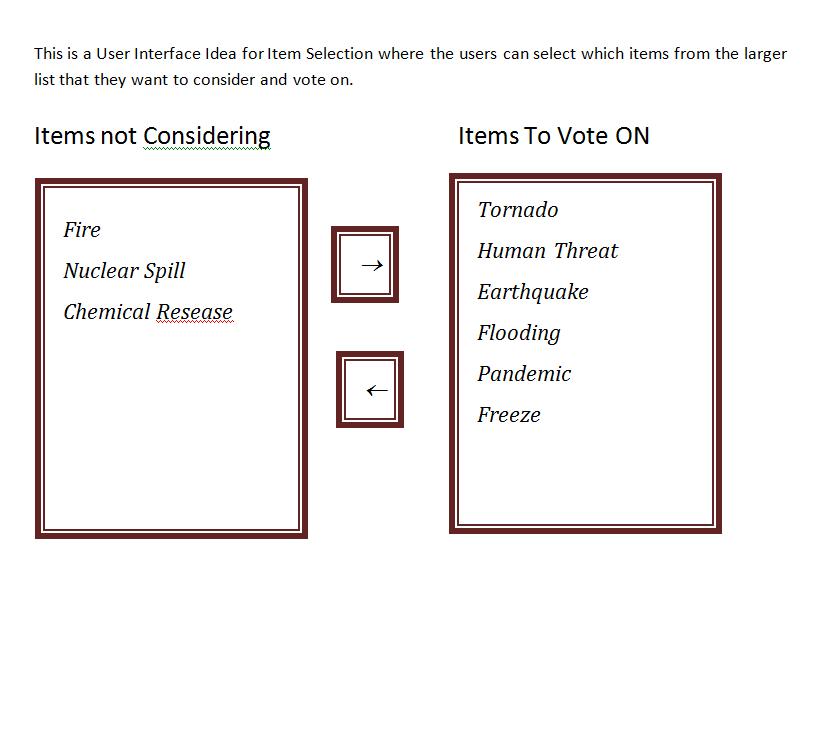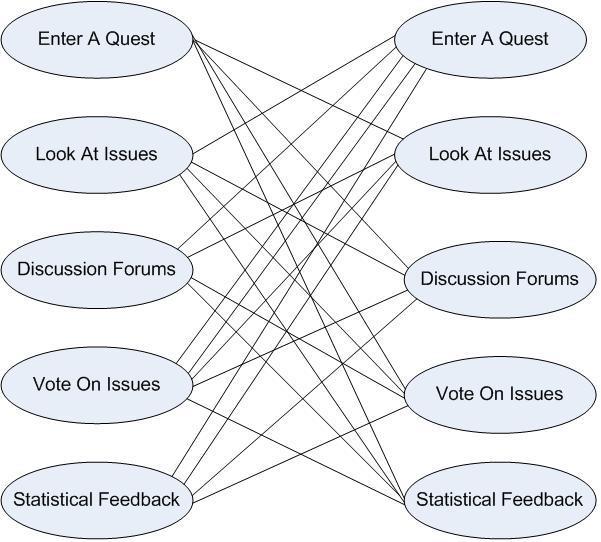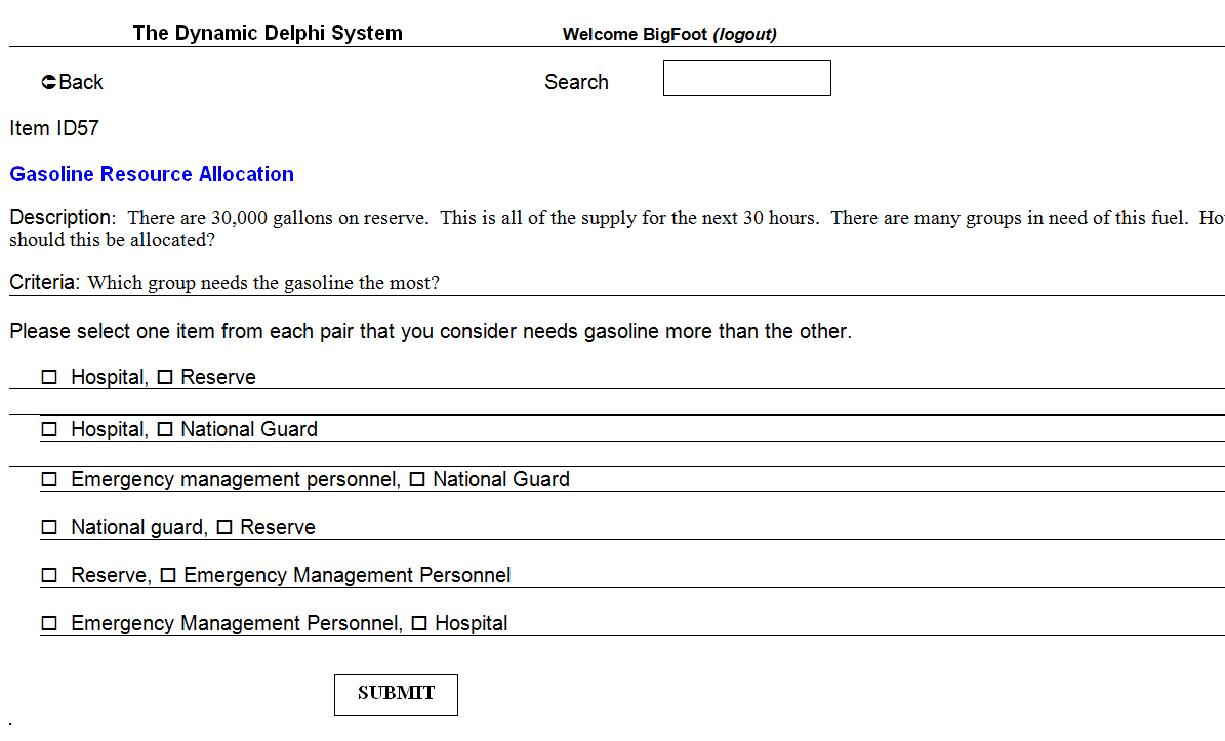| Version 26 (modified by , 16 years ago) ( diff ) |
|---|
Decision Making
The Decision Making module is designed to support decision making by large groups of Crisis Management Experts. It guides experts to generate, debate and explore alternative solutions producing an ongoing ranked list of alternative solutions that reflects the group's opinion at any point in time. This system also accounts for uncertainty.
Summary
Increasingly, extreme events demand large groups of experts distributed in both location and time to communicate, plan, and coordinate actions. When responding to extreme events, very often there are both alternative actions that might be considered and far more requests for actions than can be executed immediately. The relative desirability of each option for action could be a collaborative expression of a significant number of emergency managers and experts trying to manage the most desirable alternatives at any given time, in real time. This same decision process could be used for a number of tasks but will be designed for distributed dynamic decision making during time critical phases of extreme events. This is because our proposed system is specially designed to save time, remove ambiguities, and decrease uncertainty, major challenges described in the literature on time critical decision making during the volatile time critical phases of emergency.
Definitions
Phase I- will be used to refer to the first build of the system. This is testing how all of the functionality play together and tests to see if, together this improves group decision making ability in an online asynchronous environment. This is what's due in October.
Subjects will be used synonymously with Users and Experts. This is created for Experts who are Users of the system and Subjects of the study.
List a list is a problem that is created by someone with this permission. This is not required for Phase I due Oct. Only one discussion will be going on and this is presented to a User group who will all have the same permissions.
Item an item is a solution offered to a problem (List). Users need to be able to add an Item to the List in Phase I.
User Stories
Faculty, staff and students are going to conduct a threat assessment for their campus. These users can interact anytime and from anywhere there is an Internet connection and a browser. The user can:
1.Propose a new option to consider that is added to a List.
2.Comment on any option proposed in a discussion forum - plain text, Linear-Blog, comments should be editable (for 30 minutes after creation or something like that)
3.Vote on a relative comparison of any two options, all options should be available from which to choose on one screen. will provide screenshot idea of interface solution. Once subgroup is selected, then each item needs to be compared with the other items as paired comparisons. (can force Usersto complete all available pairs so that the calculation is easier)
4.View the votes to find both disagreements and agreements using the scale
5.Change their votes. no need to maintain individual old vote. but a 'quality control check' needs to be run to test for any cyclic triad where A is selected over B, B is selected over C, and C is selected over A. error message to User asking them to correct.
6.View a linear interval scale for the options based upon current votes as calculated from the Unit Normal Table.
7.View a modified interval scale based upon the missing votes for any options showing the degree of uncertainty in the relative position of an item in the scale resulting from those that have already voted.One scale showing worst case scenario (lower boundary) and another scale showing best case (upper boundary).
So, three scales are required for Phase I:
1) present calculation based on those who have voted
2) scale of best case scenario (calculation in technical requirements) 3) scale of vote giving worst case scenario of non-voting members
- Calculation for vote/revote (their first initial vote is kept, present vote, then a new vote (which is compared to the present vote and updated))
- Each item is voted upon with paired comparisons which produces a frequency count which is turned into a percentage number which is matched up with the corresponding number on a Unit Normal Table which finally produces a rank.
- A calculation for uncertainty is done: everyone who can vote - those who did
So there are three scales:
- one from the calculation from Thurstone (of which code is available for the unit normal conversion table)which takes many individual votes and calculates one group opinion.
- one with this, but including uncertainty (those who didn't vote) showing the best case outcome (if all votes go in favor of that item).
- and then the third shows the opposing side (uncertainty) where the items will stand on a vote given they receive no more votes.
Implementation
I think the major part is a lot of nested arrays to represent the matricies.
User Interface
Design
The following diagram shows how it's important for functionalities to be available with as few 'clicks' as possible. this saves time and gets experts to the information they need as quickly as possible. This shows the 5 primary functionalities required of the system
The Primary Interface Design mimics that of Web2Py - this design can be better seen on the original Research Proposal. link provided under 'background documentation below. Figure 10.6 Screenshot of Integrated Functionality.
-/(+) means that each list below can be expanded or contracted.
This layout corresponds with the design above.
THE DECISION MAKING MODULE USER INTERFACE Primary Page
Item Selection for Users Interface Idea

This next screen shows how paired comparisons can be presented to the user. This can be checkboxes or just something that indicates that one of the pairs has been selected over the other.
The Decision Making System
Scales Visualized for Feedback
This is the way I'd like to see the scales for feedback (3) - This is how Thurstone presented them. However, the lines drawn out to the right which bring out other dimensions is NOT required. This is just to demonstrate that other dimensions can be brought out from the results which could provide further insight. This is for a human to do though.
Background Reading
A Dynamic Delphi Process Utilizing a Modified Thurstone Scaling Method: Collaborative Judgment in Emergency Response
*http://citeseerx.ist.psu.edu/viewdoc/summary?doi=10.1.1.107.1633
The Formal Research Proposal
*http://sites.google.com/site/conniemwhite/Home/research-proposal
Need to request access:
Attachments (10)
- CollExpJud.pdf (169.5 KB ) - added by 16 years ago.
- ThurstoneScale.png (94.5 KB ) - added by 16 years ago.
- ThurstoneScale.2.jpg (32.3 KB ) - added by 16 years ago.
- ThurstoneScale.jpg (32.3 KB ) - added by 16 years ago.
- dm5.jpg (32.0 KB ) - added by 16 years ago.
- dm6.jpg (46.9 KB ) - added by 16 years ago.
- dm3.jpg (57.0 KB ) - added by 16 years ago.
- ItemSelectionUI.jpg (48.6 KB ) - added by 16 years ago.
- homeUI.jpg (149.2 KB ) - added by 16 years ago.
- pairCompUI.jpg (98.6 KB ) - added by 16 years ago.
Download all attachments as: .zip





